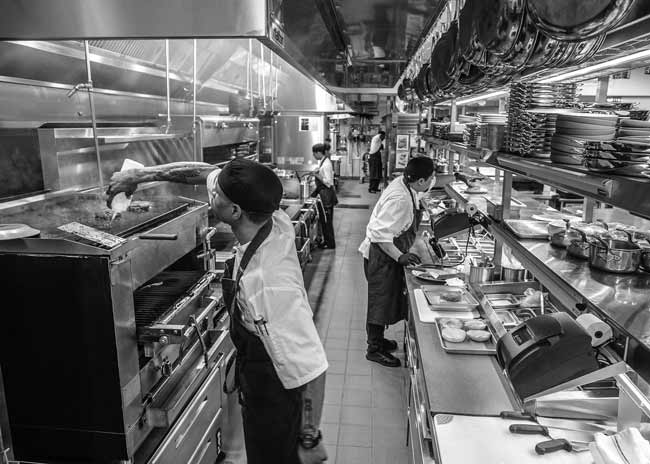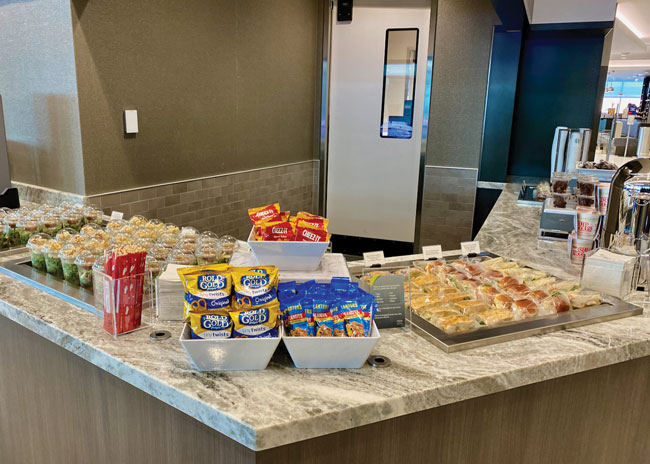 Grab-and-go containers offer a safe way to distribute self-serve items during health emergencies such as COVID. Images courtesy of Zach GriffWhen the COVID-19 pandemic effectively forced a nearly nationwide shutdown of in-person dining in 2020, establishments like Pizza Inn, a company that built its reputation on buffet-style service, had an existential crisis. Buffets and self-serve salad bars were made off-limits by health authorities in many jurisdictions, requiring the chain to radically rework its business model.
Grab-and-go containers offer a safe way to distribute self-serve items during health emergencies such as COVID. Images courtesy of Zach GriffWhen the COVID-19 pandemic effectively forced a nearly nationwide shutdown of in-person dining in 2020, establishments like Pizza Inn, a company that built its reputation on buffet-style service, had an existential crisis. Buffets and self-serve salad bars were made off-limits by health authorities in many jurisdictions, requiring the chain to radically rework its business model.
Self-service lines, where customers choose from an array of foods and ingredients and compile their own plates, could not be easily translated for a takeout and delivery world, but Pizza Inn has managed to do it. Their adjustment — providing patrons the ability to customize takeout orders via apps or by calling their local restaurant — kept the business afloat until restrictions lifted.
Fortuitously, just a couple of months before the shutdown, Pizza Inn had rolled out a plan to boost its takeout business. “Everything we have done since then has been to dodge the COVID bullet,” says Mike Burns, COO, RAVE Restaurant Group, the owner and franchisor of Pizza Inn and Pie Five. Once restrictions eased, Pizza Inn reopened its buffet service with a few tweaks.
Self-service has its advantages. Many customers enjoy all-you-can-eat buffets or the ability to customize portions and ingredients. Self-service can also reduce the amount of labor needed to staff a restaurant. So, how can establishments that want to retain self-service features make them safe, efficient, and profitable in the current environment, where the pandemic continues to be a concern with outbreaks popping up across the country? And what does the future hold when the public is more conscious of the potential for buffets, salad and dessert bars, and self-serve beverage stations to be nexuses for disease transmission?
Answers depend on a few key factors, such as:
- Business model — Does self-serve make strategic sense?
- Customer perceptions — Do your customers really want self-serve?
- Design choices — How can design make self-serve safer?
- Labor availability — Can self-serve help you with the labor shortage?
- Public health factors including local regulations
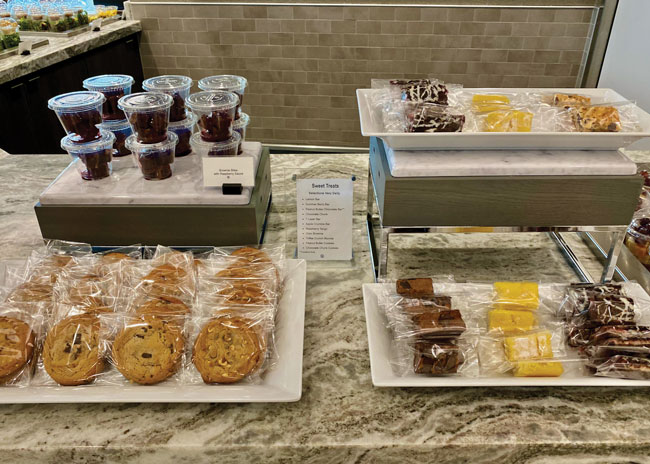 Individually wrapped items such as these dessert choices at Delta Sky Club at the Salt Lake City Airport make for convenient self-service choices.
Individually wrapped items such as these dessert choices at Delta Sky Club at the Salt Lake City Airport make for convenient self-service choices.
Even before COVID-19, some establishments were rethinking the viability of buffets and self-serve lines, says Linda Callahan, director, Next Step Design, a firm that serves on-site employee eateries and other restaurants. “The trend over the past five years has been reduced self-service for our clients,” Callahan says. Instead of self-serve, clients have added stalls where foodservice workers compile made-to-order dishes including salads. “The workplace food experience is turning to more of a restaurant-style experience,” she says. “It’s part of an effort to elevate employee dining and add more perks for employees.”
The pandemic hastened the reevaluation of self-serve features. “The initial response during COVID was to get rid of them,” Callahan says. That was the most prudent choice during the early days and the first wave of the public health crisis, but some clients turned again to self-serve when the pandemic abated and continue to offer those features today, she adds.
When considering whether to reopen buffets, Burns said he looked to Las Vegas, the so-called buffet capital of the world. After Sin City hotels reopened buffets to wide acceptance, he figured the service style still had legs. Some Las Vegas buffets did stay closed, he says, but that was because the owners no longer thought they
were profitable.
But the pizza buffet has always been profitable and central to the Pizza Inn experience, and the chain wanted to continue with the model — except in states like Kentucky that banned buffets during the pandemic. At first, the company turned to a modified buffet experience where staff served customers as they stepped up to the buffet island to make their choices. To foster social distancing, Pizza Inn sites added floor stickers spaced 6 feet apart and directional signs to ensure a one-way flow of traffic around buffet islands — the chain’s most common self-serve design.
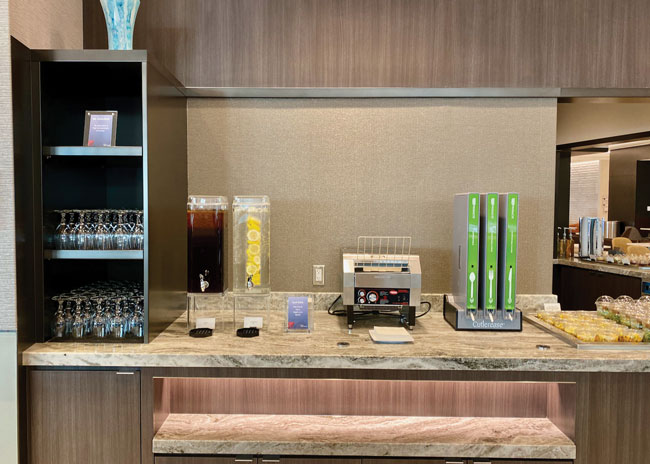 Self-service lines where customers choose from an array of foods and ingredients and compile their own plates could not be easily translated for a takeout and delivery world, but Pizza Inn has managed to do it.
Self-service lines where customers choose from an array of foods and ingredients and compile their own plates could not be easily translated for a takeout and delivery world, but Pizza Inn has managed to do it.
As the pandemic eased, Pizza Inn returned to a traditional buffet self-serve approach where permitted but maintained its one-way flow of traffic by closing one side of the buffet. The chain allows each location to adapt its own self-serve operations to comply with local regulations. That may mean continuing with staffed buffets where customers are not allowed to physically obtain their own food. However, one corporate edict does apply to all sites: All buffet counters must be sanitized every 30 minutes — a more stringent approach to cleaning than most local health regulations that typically mandate cleaning every couple of hours.
Eateries with self-serve options have made minor physical modifications to choose-your-own stations, Callahan says. Replacing food shields has been common. “A typical sneeze guard is 14 inches vertically,” she says. “It needs to be at least 18 inches to meet new standards.”
The guards — typically made of plexiglass — can be purchased with the ability to tilt up and down. This allows for the flexibility to either have both sides of an island buffet open, or to shut one side down. “Some jurisdictions do not require sneeze guards if you have self-closing lids,” Callahan points out. In most cases, new food shields can be attached to islands or bars easily, but some models may require drilling through solid surface counters such as stainless steel or Corian.
New designs that incorporate self-serve features are specifying more space for people to move about islands or bars. “We want to allow for more flexibility and movement instead of having everything in one place,” Callahan says. That fosters better social distancing.
The pandemic caused some restaurants to rethink how they provide tableware. Some substituted metal forks, spoons and knives with disposable plasticware to reduce the potential to spread the virus. Some that have since gone back to using metal utensils have upgraded their cleaning equipment to high-temperature washing to better combat pathogens, Callahan says.
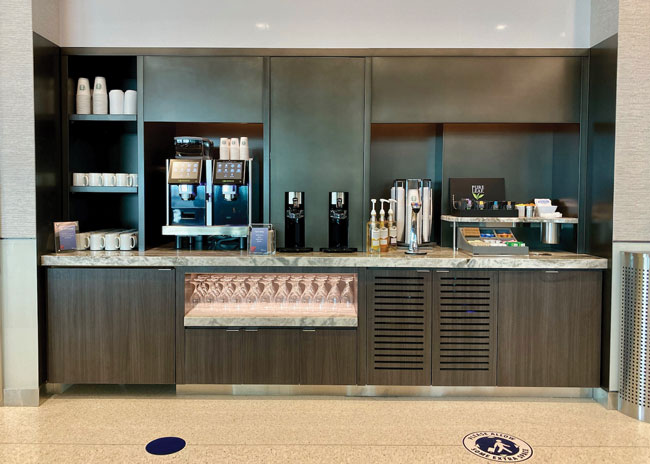 Self-serve beverage stations can ease the burden on staff. Regular monitoring of beverage levels and diligent cleaning are a must, though.
Self-serve beverage stations can ease the burden on staff. Regular monitoring of beverage levels and diligent cleaning are a must, though.
Self-service stations for disposable utensils could become more prevalent to reduce waste from carryout orders. The Chicago City Council, for example, has passed limits on plastic utensils for restaurant carryout and delivery. Windy City restaurants will be required to either provide self-service stations for customers to pick up napkins, utensils, drink trays and other disposable items or will have to ask people if they want them. That will mean counter space dedicated for this purpose will be required in many establishments where these stations are not currently offered.
Self-service generally reduces the amount of labor needed to staff a restaurant. At Pizza Inn, for instance, the popular buffet means fewer trips for servers to each table. Thus, each server can attend to as many as 20 tables per shift, Burns says. Servers deliver beverages and some a la carte dishes to tables, but overall, their trips to each table are lower than within a typical full-service establishment. The reduced need for labor is a big plus during the current tight job market.
Pizza Inn’s new design prototype eliminates island buffets in favor of a setup that positions the feature adjacent to the kitchen. The plan is for self-serve features to be one-sided so that customers keep to the side away from the kitchen. Staff will deliver food on the opposite side. This will enforce one-way flow by design. “We’re doing what we can to make sure we don’t have to shut down as a result of COVID,” Burns says. The chain’s actions can also provide some insurance against future outbreaks of highly transmissible diseases.
Some eateries that used to feature self-service are biding their time by adopting QSR-style assembly lines where staff compile meals for guests who choose their ingredients. Some establishments that used to charge self-serve meals by weight have moved to a flat-rate model, Callahan says. Some of these establishments are charging more for the addition of extra protein ingredients.
It appears that the self-serve concept, while currently diminished, will survive COVID. As the pandemic ebbs, there could be a resurgence of the model. A new initiative at Pizza Inn backs this notion. The chain is testing a new ice cream sundae bar at one Arkansas location. If it proves its worth, Pizza Inn may make it a feature at all locations. In any case, the chain plans to continue to embrace self-serve.
“The buffet is a key part of the experience,” Burns says. “Kids especially like it because they can do what they want.”


